Aquarium snails are everywhere in aquarist’s live – they inhabit in all types of tanks and sometimes they appear in the places, where it seems to be impossible. Let’s try to make a long story short and gather some information about the kinds described earlier, so then you can choose what’s interesting especially for you.
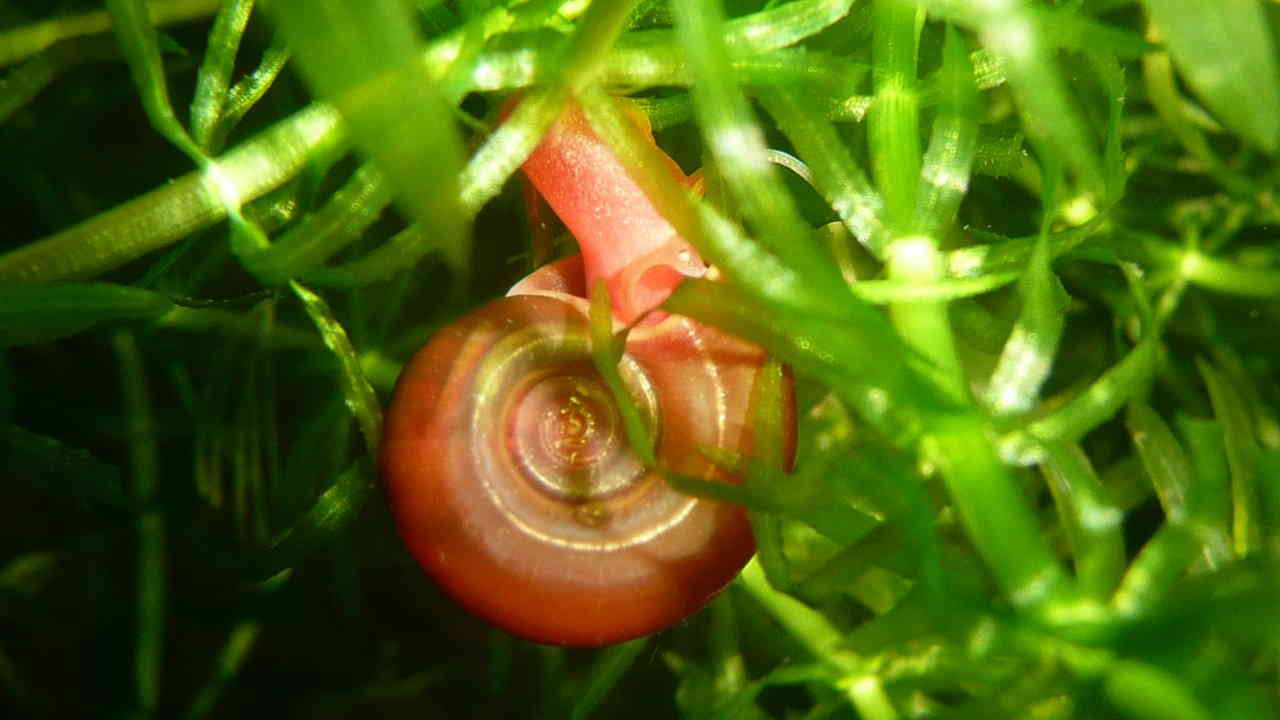
All kinds of freshwater snails are often considered as something that appears in one night, covers tank plants, gets the tank water muddy and kills tank fishes. Some of this is sometimes true, but still water snails make themselves more useful than do any damage in the tank.
Quite a lot of snails feed on food leftovers and other garbage, some of them clean tank walls and decorations, and some are just good looking species. To avoid any troubles with aquatic snails in a tank you just need to know what stimulates their rapid breeding and define which species won’t do for your tank.
In the current article we’ll go through the most popular kinds of freshwater aquarium snails, but in case you’d like to know more about each of them, just read the articles we’ve already published using the links below.
Contents
- 1 Types of aquarium snails
- 1.1 Acroloxus snail (Acroloxus lacustris)
- 1.2 Apple snails (Pomacea canaliculata, Pomacea diffusa, Pomacea maculata)
- 1.3 Assassin snail (Clea helena)
- 1.4 Bladder snail (Physella acuta)
- 1.5 Giant ramshorn snail (Marisa cornuarietis)
- 1.6 Black devil snail (Faunus ater)
- 1.7 Pagoda Snail (Brotia pagodula)
- 1.8 Malaysian Trumpet Snails (Melanoides tuberculata, Melanoides granifera)
- 1.9 Spixi Snail (Asolene spixi)
- 1.10 Nerite snails (Neritina spp.)
- 1.11 River nerite (Theodoxus fluviatilis)
- 1.12 Ramshorn snail (Planorbis corneus)
- 1.13 Rabbit Snail (Tylomelania spp.)
- 2 The role of snails in a tank
- 3 Conclusion
Types of aquarium snails
Acroloxus snail (Acroloxus lacustris)
Acroloxus snails can be an interesting addition to a freshwater aquarium. The smallest aquarium snails are acroloxus (Acroloxus lacustris) from Acroloxidae family. If you observe them from a side their shell will look like a small cap. These small snails are rather reticent and prefer to do all their activity in the twilights and in the dark.
So, if the tank owner once turns on the tank lights at night he will be very surprised, because dozens of these snails will be on the tank walls and plants. But don’t get scared, since acroloxus are considered to be harmless.
However, be aware of their population number, since they feed on leftovers and if there are a lot of them, it means that they have enough of feed. This brings another question – maybe you overfeed you fishes? Once you decrease the amount of feed given to your fishes, the number will decrease correspondingly.

Apple snails (Pomacea canaliculata, Pomacea diffusa, Pomacea maculata)
Apple snails are known for their relatively large size compared to other freshwater snails. They can grow up to 6 inches (15 centimeters) in diameter, depending on the species. Since these are one of the largest kinds their appetite corresponds to their size. Therefore, apple snails may damage young and soft tank plants in case the snails have lack of feed. As for the rest – these are good looking, large and interesting.
Apple snails are generally peaceful creatures. They spend most of their time grazing on algae and scavenging for food in the aquarium. They are known to be active during the day and can often be seen exploring the tank or climbing to the water surface to breathe air.
The most common apple snail species kept in aquariums is Pomacea diffusa (formerly known as Pomacea bridgesii), also known as the Mystery snail or spike-topped apple snail. Other popular species include Pomacea canaliculata (Golden apple snail) and Pomacea maculata (island applesnail). However, it’s important to note that some apple snail species, like Pomacea canaliculata, are considered invasive in certain regions and should not be released into the wild.

| Characteristic | Description |
|---|---|
| Common Name | Golden apple snail |
| Scientific Name | Pomacea canaliculata |
| Size | Large (up to 6 inches or 15 centimeters in diameter) |
| Shell Shape | Coiled spiral resembling an apple |
| Shell Color | Yellowish to golden with dark spiral bands |
| Body Color | Generally grayish or black |
| Habitat | Freshwater habitats, including lakes, ponds, and slow-moving rivers |
| Behavior | Diurnal activity, climbs to the water surface to breathe air |
| Diet | Omnivorous, feeds on plants, algae, and detritus |
| Water Parameters | Tolerates a range of water parameters, prefers neutral to slightly alkaline pH |
| Temperature Range | 68°F – 82°F (20°C – 28°C) |
| Tank Size | Depends on the size of the snail, typically medium to large |
| Compatibility | Peaceful, compatible with most community fish species |
| Reproduction | Male and female reproductive organs, lay eggs above the waterline |
| Lifespan | Varies, typically 1-2 years in the wild, potentially longer in captivity |
| Conservation Status | Invasive species in many regions, can cause ecological harm and is subject to control measures |
Assassin snail (Clea helena)
Assassin snail is one of the most unusual kinds. The thing is that they feed on the other snails. So if you have lots of snails in your tank, this kind of snail is one of the ways to get rid of them. However, if there are no other snails in the tank assassin snail will feed on common types of snails feed.
Assassin snails are primarily nocturnal creatures, being most active during the night. They are known to burrow in the substrate and are skilled predators. They have a unique hunting strategy, targeting and feeding on other snails in the aquarium. Assassin snails are generally peaceful and can coexist with most community fish species. They are not aggressive toward other tank inhabitants unless threatened. However, it’s important to note that they are specialized snail predators, so they may not be suitable for snail-inclusive setups or tanks with snail species you wish to preserve.
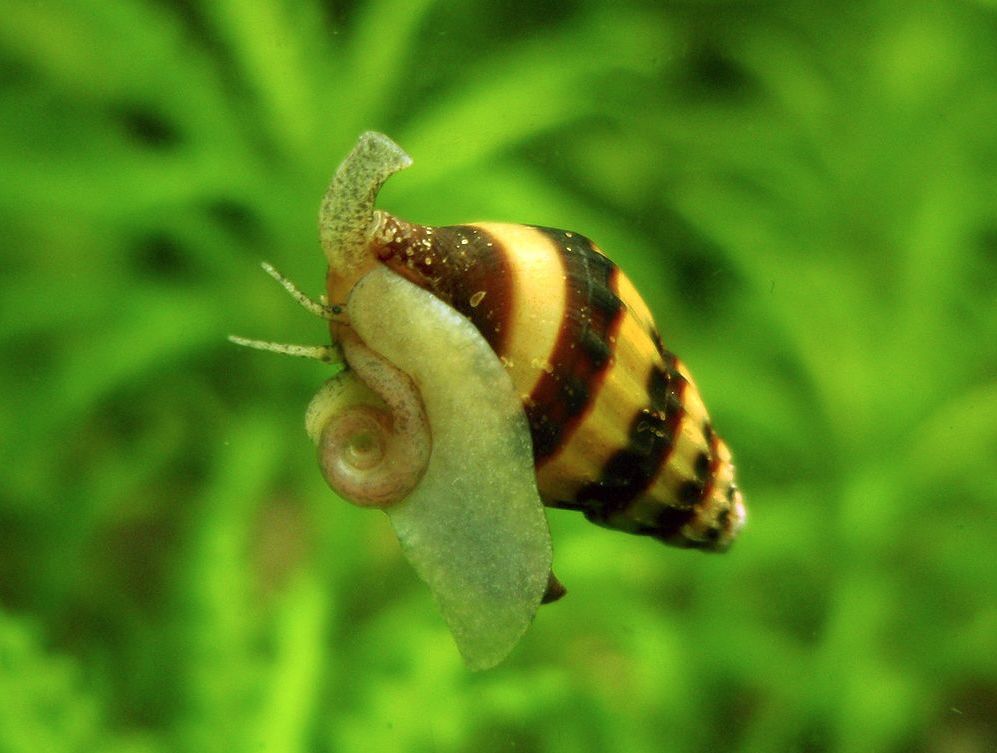
| Characteristic | Description |
|---|---|
| Common Name | Assassin snail |
| Scientific Name | Clea helena |
| Size | Small to medium-sized (around 1 inch or 2.5 centimeters) |
| Shell Shape | Tapered, conical shell with a pointed apex |
| Shell Color | Yellowish to brown with dark spiral bands |
| Body Color | Generally grayish or black |
| Habitat | Freshwater habitats, including rivers and ponds |
| Behavior | Nocturnal activity, burrows in substrate, hunts and feeds on other snails |
| Diet | Carnivorous, primarily feeds on other snails |
| Water Parameters | Tolerates a range of water parameters, prefers neutral to slightly alkaline pH |
| Temperature Range | 68°F – 82°F (20°C – 28°C) |
| Tank Size | Small to medium-sized, suitable for most aquarium sizes |
| Compatibility | Generally peaceful, compatible with most community fish species |
| Reproduction | Male and female reproductive organs, lay eggs in small clusters |
| Lifespan | Varies, typically 1-3 years |
| Conservation Status | Not a conservation concern |
Bladder snail (Physella acuta)
Snails from Physidae family can be seen in tanks and the most common ones are Physella acuta. Physella acuta is a species of freshwater snail commonly known as the Bladder snail or Acute bladder snail. These are small but rather fast snails with sinistrality turned shell.
They have quite pronounced raised folds of their pallium which serve as grills and let the bladder snails stay under water for a long time despite the fact that these snails are too active and consume a large amount of oxygen. Fishes may eat these snails in aquarium, but not very eagerly.
Physella acuta has a small, elongated, and cone-shaped shell with a pointed tip. The shell color can vary from translucent to light brown or gray. Adult bladder snails typically reach a size of about 0.5 centimeter (0.2 inches) in length. Bladder snails are generally active and agile swimmers. They are known to have a high reproductive rate, and their populations can rapidly increase under favorable conditions.
Bladder snails are generally peaceful and can coexist with most community fish species. However, they have a high reproductive capacity, and in certain cases, their populations can become excessive. It’s important to monitor their numbers and take appropriate measures if necessary.
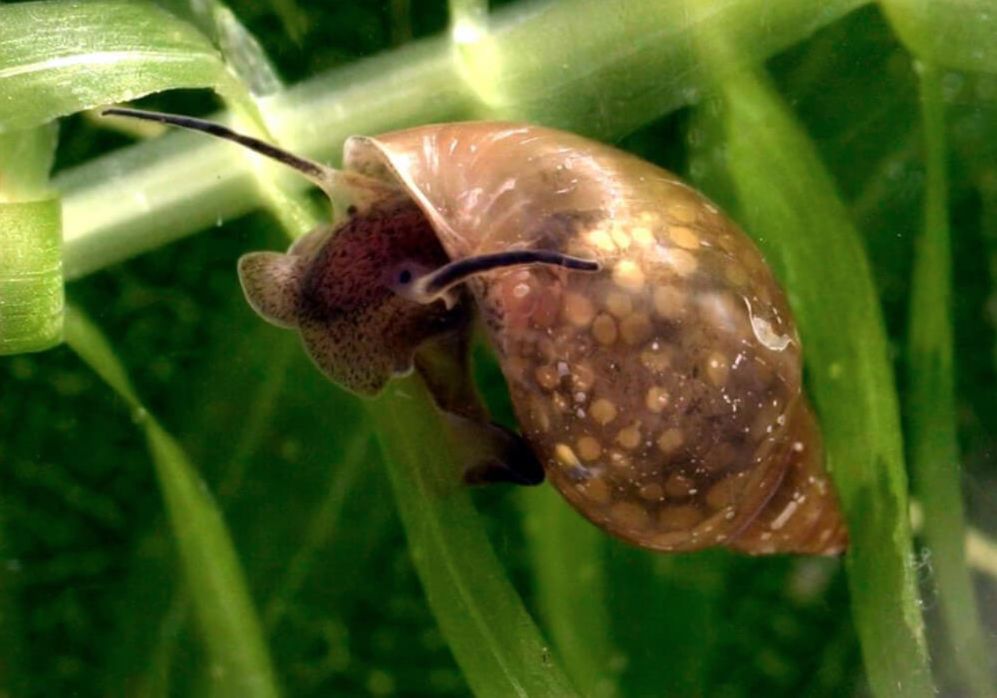
| Characteristic | Description |
|---|---|
| Common Name | Bladder snail, Acute bladder snail |
| Scientific Name | Physella acuta |
| Size | Small, approximately 0.5 centimeter (0.2 inches) in length |
| Shell Shape | Elongated, cone-shaped with a pointed tip |
| Shell Color | Translucent to light brown or gray |
| Body Color | Typically light gray or brownish |
| Habitat | Freshwater habitats, including lakes, ponds, and slow-moving rivers |
| Behavior | Active swimmers, agile movement |
| Diet | Omnivorous, feeds on algae, detritus, decaying plant matter |
| Water Parameters | Tolerates a wide range of water parameters, adaptable to both soft and hard water |
| Temperature Range | 65°F – 82°F (18°C – 28°C) |
| Tank Size | Suitable for most aquarium sizes |
| Compatibility | Generally peaceful, compatible with most community fish species |
| Reproduction | Simultaneous hermaphrodites, capable of self-fertilization, lay eggs in gelatinous clusters below the waterline |
| Lifespan | Varies, typically a few months to a year |
| Conservation Status | Not a conservation concern |
Giant ramshorn snail (Marisa cornuarietis)
Marisa is the largest aquarium snail which can grow to be 7 cm large and more. It’s large and very gluttonous therefore it’s not good for community tanks, since it quite often eats tank plants entirely. Marisa cornuarietis is an active snail that spends most of its time in the water column or grazing on surfaces such as plants, rocks, or glass. They are known for their voracious appetite and constant movement.
Giant ramshorn snails are herbivorous and primarily feed on aquatic vegetation. They will graze on various types of algae, soft-leaved plants, and detritus. However, they may also consume decaying plant matter and occasionally scavenge on other food sources.
Please note that Marisa cornuarietis is banned in some regions due to its potential as an invasive species in certain aquatic environments. Always check local regulations before keeping or introducing any snail species to an ecosystem outside of their natural range.
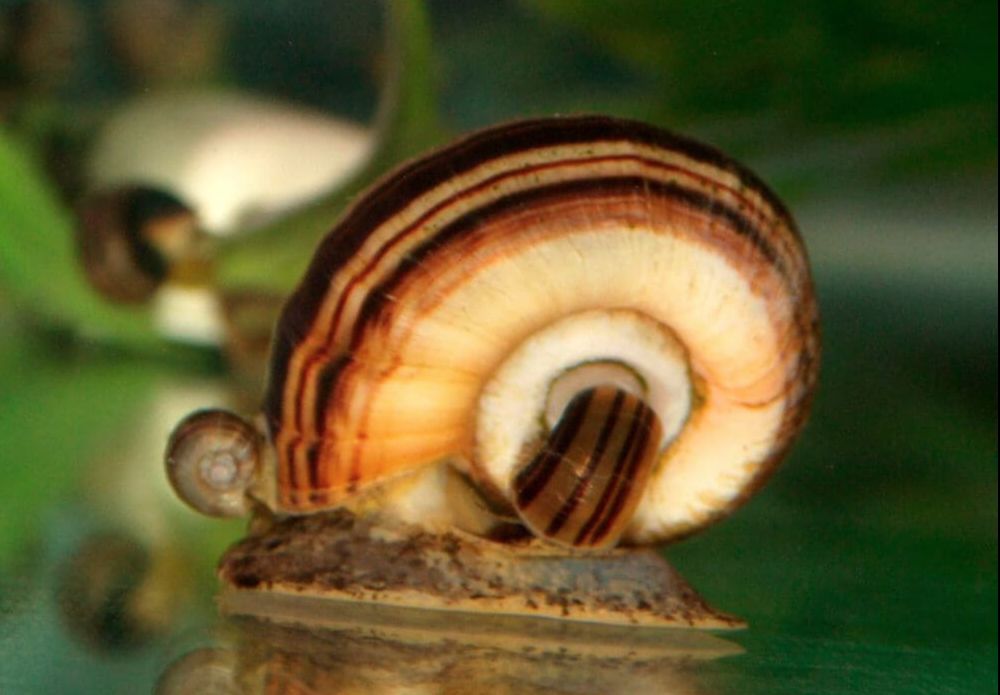
| Characteristic | Description |
|---|---|
| Common Name | Giant ramshorn snail, Colombian ramshorn snail |
| Scientific Name | Marisa cornuarietis |
| Size | Large, up to 2-3 inches (5-7.5 centimeters) in diameter |
| Shell Shape | Coiled shell |
| Shell Color | Light brown to dark brown with lighter bands |
| Body Color | Dark gray or black |
| Habitat | Freshwater habitats, including lakes, ponds, and slow-moving rivers |
| Behavior | Active and constantly moving |
| Diet | Herbivorous, feeds on aquatic vegetation, algae, soft-leaved plants, and detritus |
| Water Parameters | Tolerates a wide range of water parameters, pH 6.5-8.0, temperature 70°F-82°F (21°C-28°C) |
| Tank Size | Suitable for larger aquariums due to their size |
| Compatibility | Generally peaceful, compatible with many community fish species |
| Reproduction | Hermaphroditic, capable of self-fertilization, lay clusters of eggs above the waterline or on surfaces near the water |
| Lifespan | Varies, typically a few years |
| Conservation Status | Not a conservation concern |
Black devil snail (Faunus ater)
Faunus ater, commonly known as the black devil spike snail is a species of brackish water snail that can be kept in freshwater aquariums. Faunus ater can be an intriguing addition to an aquarium, adding visual interest and assisting with algae control. However, their larger size and potential impact on delicate tank inhabitants should be considered when deciding to keep them in a particular setup.
Faunus ater has a unique and striking appearance. It has a large, conical shell with a black or dark brown coloration. The shell often has ridges and grooves, resembling a black helmet, hence its common name.
Adult Black devil snails can grow up to 2 inches (5 centimeters) in length, making them relatively large compared to other snail species. Faunus ater is generally peaceful and spends most of its time exploring the aquarium and grazing on algae or detritus. They are slow-moving snails and prefer to stay at the bottom of the tank.
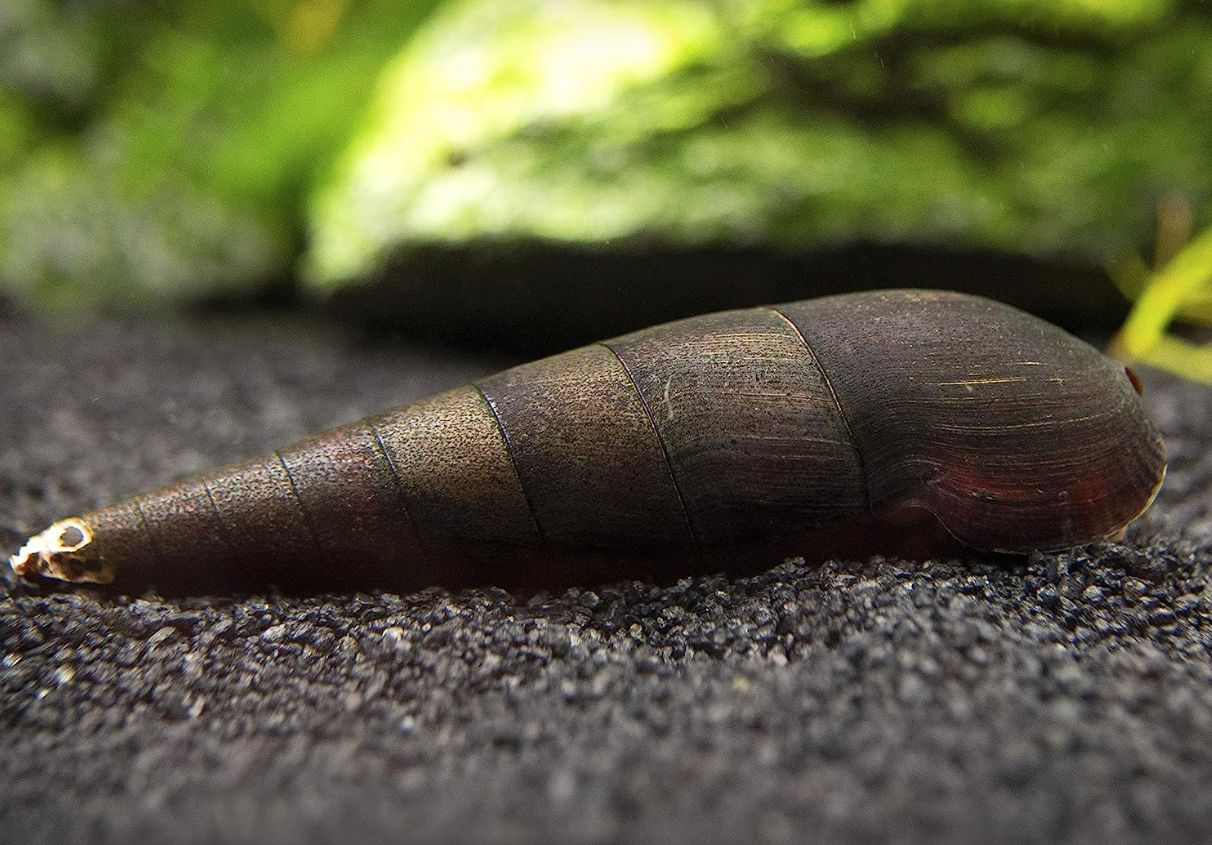
| Characteristic | Description |
|---|---|
| Common Name | Black devil snail, Black helmet snail |
| Scientific Name | Faunus ater |
| Size | Large, up to 2 inches (5 centimeters) in length |
| Shell Shape | Conical with ridges and grooves |
| Shell Color | Black or dark brown |
| Body Color | Black or dark brown (Body is usually not visible due to the shell) |
| Habitat | Brackish water and freshwater habitats, including lakes, ponds, and slow-moving rivers |
| Behavior | Slow-moving, bottom-dwelling |
| Diet | Omnivorous, primarily feeds on algae, biofilm, decaying plant matter, and uneaten fish food |
| Water Parameters | Tolerates a wide range of water parameters, prefers neutral to slightly alkaline pH |
| Temperature Range | 68°F – 82°F (20°C – 28°C) |
| Tank Size | Suitable for most aquarium sizes |
| Compatibility | Generally peaceful, compatible with most community fish species |
| Reproduction | Gonochoristic (separate sexes), requires a male and a female for reproduction. Females lay small capsules containing eggs |
| Lifespan | Varies, typically a few years |
| Conservation Status | Not a conservation concern |
Pagoda Snail (Brotia pagodula)
Brotia pagodula, commonly known as the pagoda snail or tower snail, is a freshwater snail species that belongs to the family Pachychilidae. The shell of Brotia pagodula is conical in shape, resembling a tower or a pagoda. It has a smooth surface with distinct growth lines and can vary in color from light brown to dark brown or black. The shell’s height can reach up to 2-3 centimeters (0.8-1.2 inches).
Pagoda snails are detritivores, meaning they primarily feed on decaying organic matter, algae, and biofilm found on various surfaces. They play a crucial role in aquariums by helping to clean up excess waste and maintaining the overall ecological balance. Brotia pagodula is a peaceful and non-aggressive snail species that coexists well with other peaceful aquarium inhabitants.

| Characteristic | Description |
|---|---|
| Common Name | Pagoda Snail, Tower Snail |
| Scientific Name | Brotia pagodula |
| Family | Pachychilidae |
| Shell Shape | Conical, resembling a tower or pagoda |
| Shell Color | Light brown to dark brown or black |
| Shell Height | Up to 2-3 centimeters (0.8-1.2 inches) |
| Operculum | Present, covers the shell opening when retracted |
| Native Region | Southeast Asia (Thailand, Malaysia, Borneo, Sumatra) |
| Habitat | Freshwater environments: streams, rivers, swamps, ponds |
| Preferred Substrate | Sandy or fine substrate |
| Feeding Behavior | Detritivore, consumes decaying organic matter, algae, biofilm |
| Compatibility | Peaceful and non-aggressive, suitable for community tanks |
| Care Requirements | Clean, oxygenated water; avoid copper-based medications |
| Breeding Method | Sexual reproduction, females release miniature snails |
Malaysian Trumpet Snails (Melanoides tuberculata, Melanoides granifera)
Melaniidae family snails, known as MTS snails. Two kinds of them are the most spread in tanks all over the world – Melanoides tuberculata and Melanoides granifera.
MTS are spread just like the ramshorn snails, but they differ from the latter not only in their appearance, but also in their lifestyle. They live and breed in a tank substrate, which is good for the tank since mix the substrate. However, these snails tend to have a large population and they aren’t easy to get rid of, since fishes don’t feed on them greatley and MTS hide in the tank substrate.
Malaysian trumpet snails are burrowing snails and spend a significant amount of time buried in the substrate of the aquarium. They extend their long, pointed snout above the substrate surface to feed. They are detritivores and feed on decaying plant matter, uneaten fish food, and organic debris in the aquarium. They also consume microorganisms and algae that form on surfaces.
These snails are well-suited for a variety of aquarium setups. They appreciate a substrate that allows burrowing, such as sand or fine gravel. Providing hiding spots like caves or plants can offer them security and shelter.
Malaysian Trumpet snails are often sought after for their burrowing behavior and their ability to help maintain a healthy aquarium substrate. However, it’s essential to monitor their population to prevent excessive growth in smaller tanks or if their burrowing activity becomes disruptive.
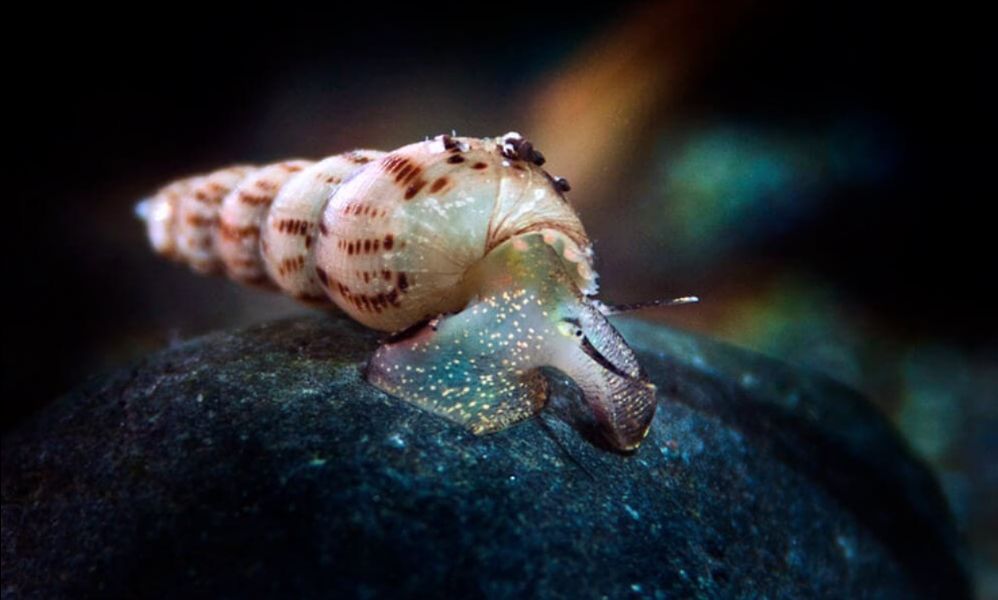
| Characteristic | Description |
|---|---|
| Common Name | Malaysian Trumpet Snail, MTS snail |
| Scientific Name | Melanoides tuberculata |
| Size | Small, typically 0.5 (1.2 centimeters) in length |
| Shell Shape | Conical with distinct spiral ridges |
| Shell Color | Light brown to dark brown or black |
| Body Color | Gray or black |
| Habitat | Freshwater habitats, including lakes, ponds, and slow-moving rivers |
| Behavior | Burrowing snails, spend time buried in the substrate and extend their snout above the surface to feed |
| Diet | Detritivores, feed on decaying plant matter, organic debris, microorganisms, and algae |
| Water Parameters | Tolerates a wide range of water parameters, pH 7.0-8.0, temperature 72°F-82°F (22°C-28°C) |
| Tank Size | Suitable for various aquarium sizes |
| Compatibility | Peaceful and compatible with most community fish species |
| Reproduction | Live-bearers, give birth to live offspring |
| Lifespan | Varies, typically a couple of years |
| Conservation Status | Not a conservation concern |
Spixi Snail (Asolene spixi)
It is a species of freshwater snail belonging to the Ampullariidae family. Asolene spixi is commonly known as the spixi snail. It is native to South America, specifically Brazil and Argentina. The species is known for its distinctive shell shape and coloration. The shell is conical with a sharp apex and can vary in color from light brown to dark brown or reddish-brown, often with dark spiral bands. Asolene spixi is an active and relatively hardy snail species that is frequently kept in freshwater aquariums.
Asolene spixi is an omnivorous species, and while they primarily feed on plant matter and algae, they have been observed consuming small invertebrates like hydra. The snails use their radula (a specialized feeding organ) to scrape and consume these prey items.
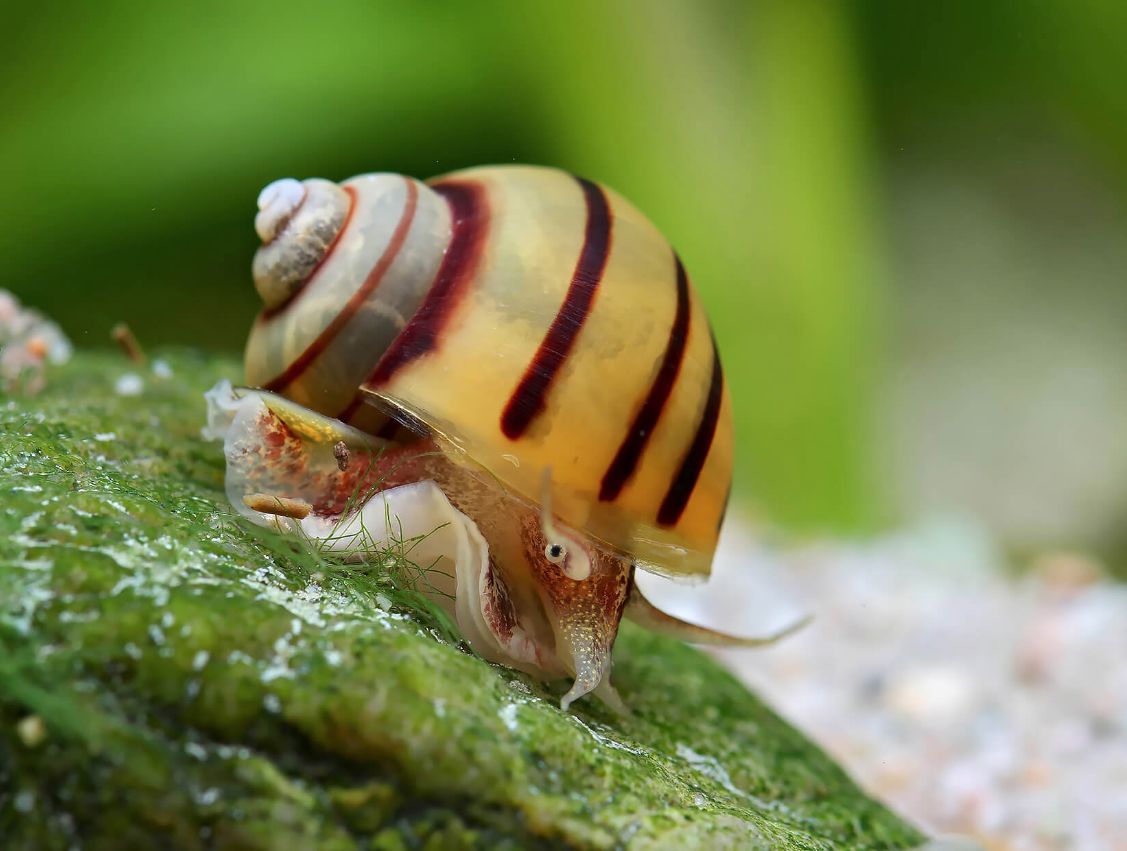
| Characteristic | Description |
|---|---|
| Common Name | Spixi Apple Snail, Spixi Snail |
| Scientific Name | Asolene spixi |
| Family | Ampullariidae |
| Shell Shape | Conical shell with a sharp apex |
| Shell Color | Light brown to dark brown or reddish-brown, often with dark spiral bands |
| Native Region | South America: Brazil and Argentina |
| Habitat | Freshwater environments: ponds, lakes, slow-moving rivers |
| Size | Can grow up to approximately 5 centimeters (2 inches) in diameter |
| Behavior | Active and relatively mobile snails |
| Feeding Behavior | Omnivorous, feed on plant matter, algae, and occasionally small insects |
| Care Requirements | Requires a well-maintained freshwater aquarium |
| Water Parameters | Prefer neutral to slightly alkaline water, temperature around 22-28°C (72-82°F) |
| Compatibility | Generally peaceful, may eat soft aquatic plants |
| Reproduction | Lay eggs above the waterline, often on the tank walls or aquarium décor |
| Lifespan | Can live up to a few years under proper care |
Nerite snails (Neritina spp.)
Nerite snails is a good looking and very useful. Nerite snails have a unique and ornate shell with various patterns and colors. The shell can be striped, dotted, or have intricate designs. The coloration ranges from black, brown, olive green, to yellowish. The body of the snail is usually small and hidden within the shell.
It’s quite small (about 2,5 cm or 1 in large), these snails perfectly clean the tank from algae. Nerite snails are valued for their algae-eating abilities and their aesthetic appeal in aquariums. They are a popular choice for both beginner and experienced aquarists due to their low maintenance requirements and helpful contribution to maintaining a clean and algae-free tank environment.
These snails are voracious algae eaters and are highly efficient in controlling algae growth in the aquarium. They feed on different types of algae, including green spot algae, diatoms, and soft algae films. However, they may require supplemental feeding if the algae supply becomes scarce.
Nerite snails are relatively small, typically growing to around 0.5 to 1 inch (1.2 to 2.5 centimeters) in length, depending on the species.
The only drawback is their price and short lifespan (about a year) and the fact that they tend to lay the eggs which don’t hatch in freshwater and spoil the tank appearance. Nerite snails advantage is the number of species with different appearance and shape.

| Characteristic | Description |
|---|---|
| Common Name | Nerite snail |
| Scientific Name | Various species, such as Neritina natalensis, Neritina reclivata, Neritina semiconica, etc. |
| Size | Small, typically 0.5 to 1 inch (1.2 to 2.5 centimeters) in length |
| Shell Shape | Varied, with unique patterns and designs |
| Shell Color | Black, brown, olive green, yellowish |
| Body Color | Typically hidden within the shell |
| Habitat | Freshwater habitats, ranging from rivers, streams, and estuaries to brackish or saltwater environments |
| Behavior | Algae grazers, spend time crawling on surfaces |
| Diet | Algae eater, feeds on different types of algae, including green spot algae, diatoms, and soft algae films |
| Water Parameters | Prefer slightly alkaline to slightly acidic water (pH 7.5-8.5), temperature 72°F-78°F (22°C-26°C) |
| Tank Size | Suitable for various aquarium sizes |
| Compatibility | Generally peaceful, compatible with most community fish species |
| Reproduction | Require brackish or saltwater conditions to reproduce; unlikely to breed successfully in freshwater aquariums |
| Lifespan | Varies, typically a couple of years |
| Conservation Status | Not a conservation concern |
River nerite (Theodoxus fluviatilis)
Theodoxus snails are primarily herbivorous and feed on algae (especially green dust algae, diatoms algae and green spot algae) and plant matter. It’s important to ensure a sufficient food source for them. Theodoxus snails can be kept in aquariums, but it’s important to note that they have specific care requirements and may not be as commonly available as some other aquarium snail species.
As Theodoxus snails may not be as readily available in the aquarium trade, it’s important to consult with experienced hobbyists or specialized aquarium stores to obtain these snails and ensure proper care.
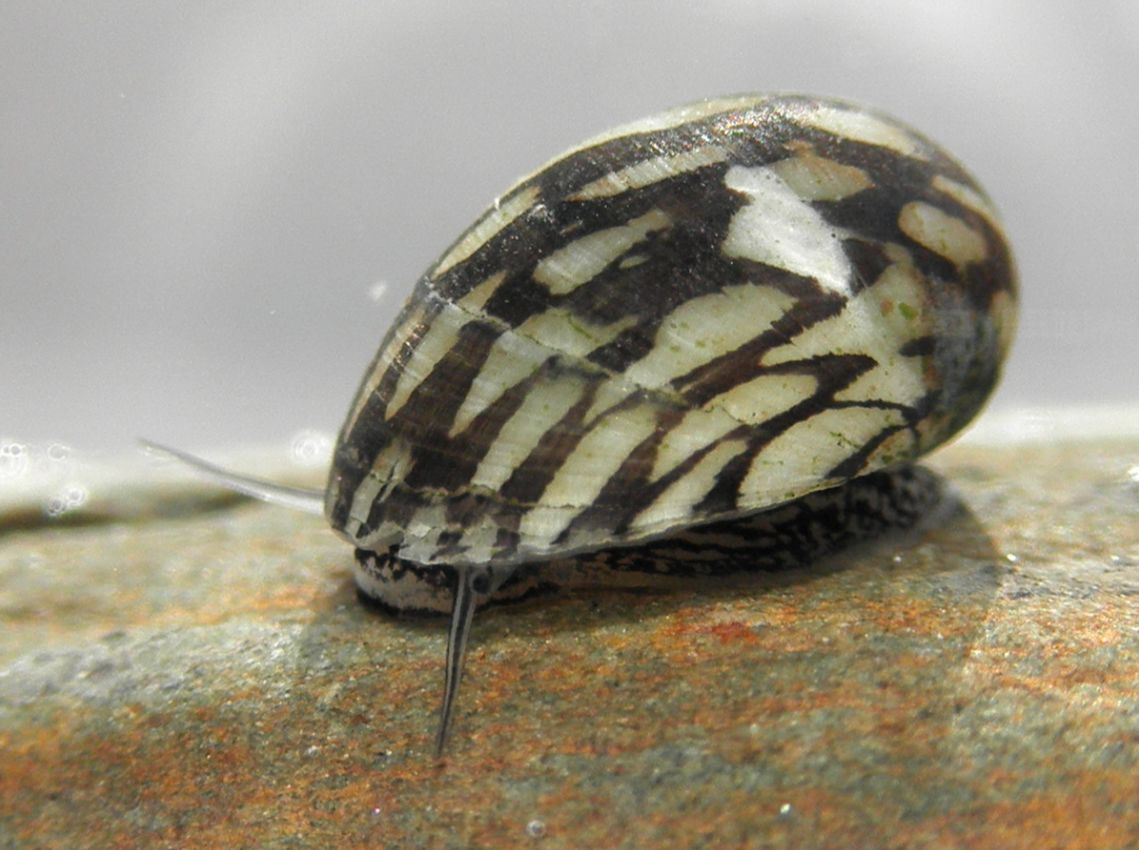
| Characteristic | Description |
|---|---|
| Genus | Theodoxus |
| Family | Neritidae |
| Shell Shape | Small and rounded |
| Shell Color | Varies, often brown, gray, or greenish, with white bands or patterns |
| Size | Typically 0.5 centimeters (0.2 inches) in diameter |
| Habitat | Freshwater rivers, streams, lakes, and some species can tolerate brackish water |
| Behavior | Generally slow-moving, attached to rocks or submerged vegetation |
| Feeding Behavior | Herbivorous, primarily feed on algae and plant matter |
| Water Parameters | Clean, well-oxygenated water, neutral to slightly alkaline pH |
| Tank Size | Suitable for various aquarium sizes |
| Substrate | Sand or fine gravel |
| Water Flow | Moderate water flow |
| Compatibility | Generally peaceful, compatible with compatible fish and invertebrates |
| Breeding | Sexual reproduction, lay eggs that develop into larvae |
Ramshorn snail (Planorbis corneus)
Ramshorn snail’s shell (Planorbarius corneus and Planorbis corneus) from Planorbidae family meets all the childhood stereotypes of how the snail should look like. In general is a classical snail, that can be seen almost in any tank. In the wild feeds mainly on algae and bacterial slime.
Ramshorn snails are often considered both a pest and a beneficial addition to aquariums, depending on their population density and the specific needs of the aquarium ecosystem. Ramshorn snails are primarily herbivores, but they can also consume detritus and decaying organic matter in the aquarium.
Ramshorn snails are typically active during the day and may exhibit both bottom-dwelling and surface-swimming behaviors.
In a tank this slime looks like some gray films on tank walls, plants and on the water surface. When eating these things do good for the tank, but they still they aren’t very thorough cleaners. These snails don’t clean anything completely, they eat out some kind of traces clearly seen on a tank walls. In moderate number are useful in a tank.
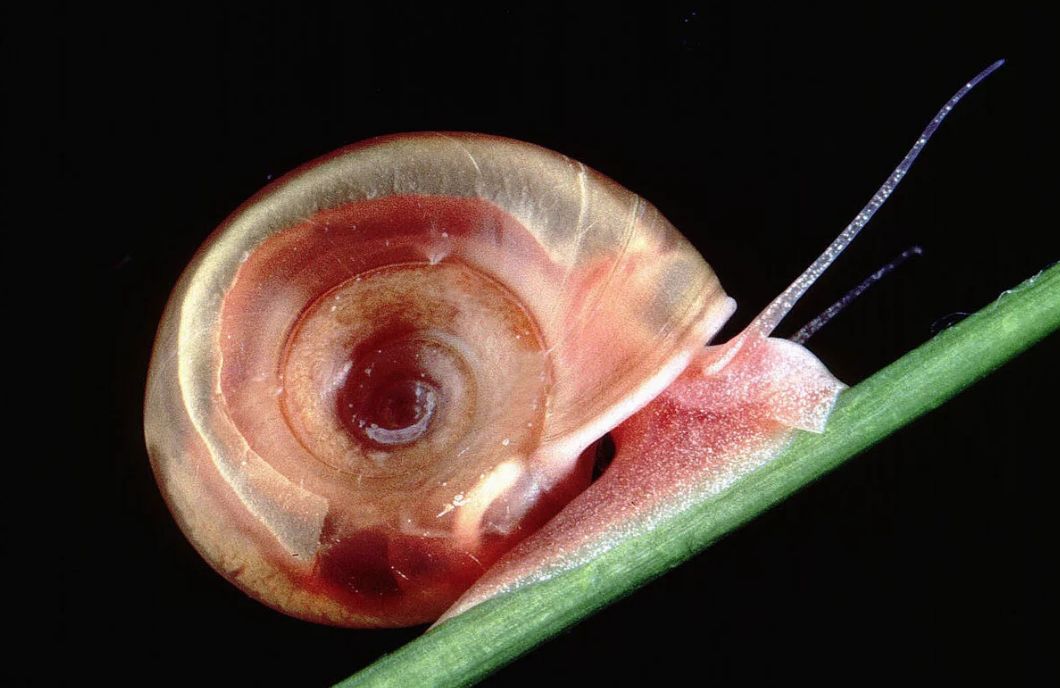
| Characteristic | Description |
|---|---|
| Common Name | Ramshorn Snail |
| Scientific Name | Family: Planorbidae |
| Genus: Planorbis (common genus) or other species-specific | |
| Shell Shape | Disc-shaped or spiral, resembling a ram’s horn |
| Shell Color | Varies: brown, red, pink, blue |
| Size | Varies, typically a few millimeters to a couple of cm |
| Habitat | Freshwater: ponds, lakes, rivers, and aquariums |
| Water Parameters | Tolerant of a wide range; prefer slightly alkaline water |
| Feeding Behavior | Herbivorous, graze on algae and organic matter |
| Behavior | Active during the day, may exhibit bottom-dwelling and |
| surface-swimming behaviors | |
| Care Requirements | Hardy and adaptable, stable water conditions preferred |
| Temperature: 20-28°C (68-82°F), pH: 7.0-7.5 | |
| Reproduction | Sexual and asexual reproduction possible |
| Can lay gelatinous egg masses, capable of rapid growth |
Rabbit Snail (Tylomelania spp.)
Tylomelania sp., commonly known as rabbit snails, is a genus of freshwater snails that belongs to the family Pachychilidae. The genus Tylomelania includes several species, each with its own distinct characteristics. The size of Tylomelania snails can vary depending on the species, ranging from around 4 to 8 centimeters (1.5 to 3 inches) in length. They are primarily detritivores, feeding on decaying plant matter, algae, and biofilm. They can also consume leftover fish food and other organic debris in the aquarium.
This kind rapidly becomes popular. Despite they are very beautiful, these snails are also very demanding to the tank conditions. They are more likely to be some kind of exotic tank inhabitants that should be kept separately and should be taken care of, then considered as common species.
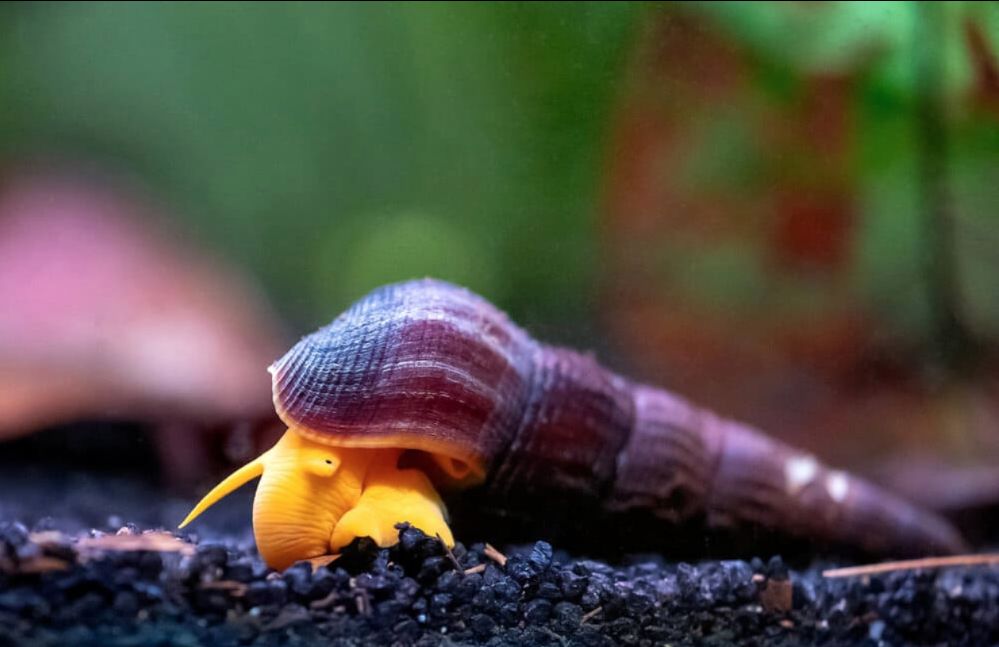
| Characteristic | Description |
|---|---|
| Common Name | Rabbit Snails |
| Scientific Name | Genus: Tylomelania |
| Family | Pachychilidae |
| Shell Shape | Elongated and cone-shaped |
| Shell Color | Varies: brown, yellow, orange, black, with striped or spotted patterns |
| Size | Varies, typically 4-8 centimeters (1.5-3 inches) in length |
| Habitat | Freshwater: endemic to Sulawesi, Indonesia |
| Water Parameters | Prefer slightly alkaline to neutral water, moderate to high hardness |
| Feeding Behavior | Detritivores, feed on decaying plant matter, algae, and biofilm |
| Behavior | Peaceful and slow-moving |
| Care Requirements | Stable water parameters, slightly alkaline to neutral pH, moderate hardness |
| Preferred Substrate | Sand and fine gravel for burrowing and sifting through |
| Compatibility | Generally peaceful, but interactions may vary with other tank mates |
| Breeding Method | Sexual reproduction, eggs laid in substrate or attached to surfaces |
| Juveniles hatch from eggs after a gestation period |
The role of snails in a tank
The most common way of how snails get into the tank is together with the tank plants you have bought or with the tank substrate you haven’t cleaned before putting into the tank.
As a rule eggs is stuck to the tank plant leaves and after putting them inside the tank you get the juveniles in your aquarium later. If you’ll control the number of population, there’s no need to do anything about their presence in the tank.
The thing is that besides the scenic value snails also do a lot to clean the tank. Actually, snails are natural cleaners which clean the plants from algae, feed on dead parts of plants leaves and tank fish feed leftovers.
So, more often we see the following kinds in aquarium.
Conclusion
Almost all kinds of aquarium snails are well behaved tank inhabitants, only some of them require some special conditions that don’t fit community tank conditions. They become a problem only in case when something is wrong in the tank and still it’s not a problem it’s just a signal.
We’ve mentioned above the most common kinds and in other articles the species were described in more details. So, please, read, speculate and choose which of them suits you best.